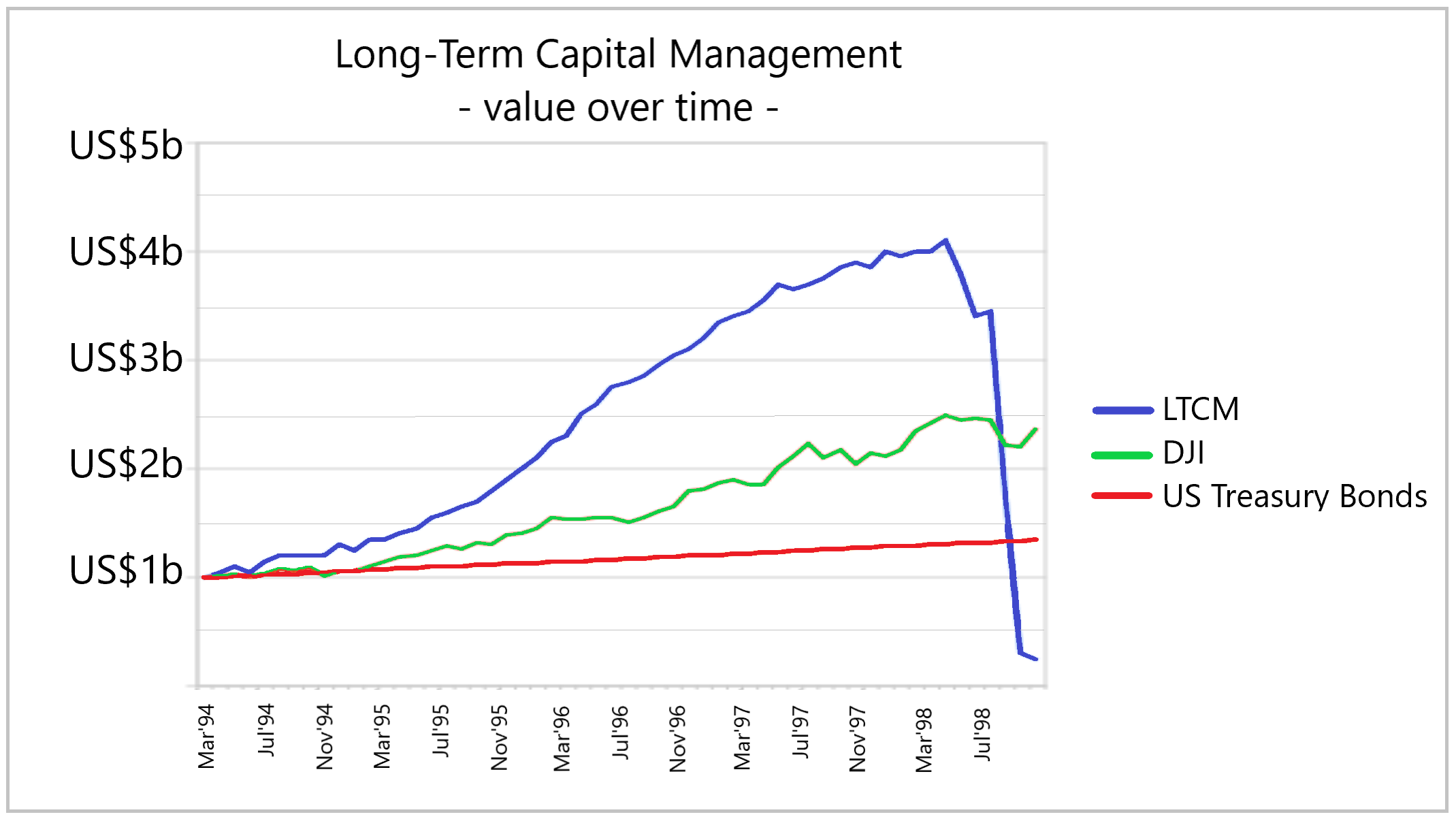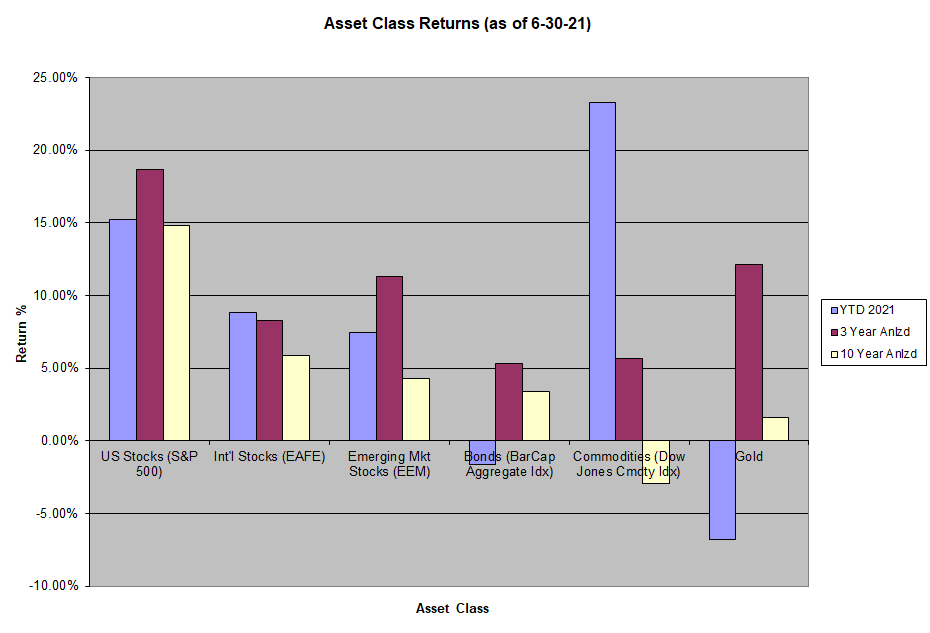In 1994 a legendary wall street bond trader launched a new hedge fund with $1 billion in assets, recruiting several top traders, two future Nobel prize winners and several PhD’s from MIT. In its first three years the fund posted stellar returns of 21%, 43% and 41%. The fund achieved these returns, in part, by utilizing massive leverage. At its height in 1998 the fund had approximately $5 billion in assets, controlled over $100 billion and had positions whose total worth was over $1 trillion.
But in 1998 a series of global macro events had caused many of the funds trades to sour. Things took a significant turn for the worse following the Russian government’s default on its sovereign debt that August. The fund was poorly positioned for what followed, and its immense leverage caused it to sustain massive losses. These losses spilled over in to the broader market with the S&P 500 dropping ~ 19% that summer, as fears of a financial contagion took hold. By September of 1998, fearing an even wider collapse in financial markets, the Federal Reserve Bank of New York organized a bailout of $3.625 billion by the fund’s major creditors. The fund, Long-Term Capital Management (LTCM), was liquidated in 2000.

Chart from LinkedIn
Now consider the case of Grace Groner, born in 1909 and orphaned at age 12. In 1935 Grace purchased three shares of Abbot Labs, where she also worked for 43 years, mostly as a secretary. Over the years her shares split many times, but she held them through the end of her life, enduring bear markets, economic recessions and periodic declines of more than 50% in the value of her shares along the way. It is said Grace was frugal, but that she travelled extensively and gave to the needy, though keeping her name anonymous. Grace died on January 19, 2010. Shortly thereafter it was revealed that her estate totaled in excess of $7 million dollars – almost entirely from that original investment of $180. The estate was left to a foundation that she established in 2008, and funds are used to support the students of her alma mater Lake Forest College.

From Ycharts.com
Lessons from LTCM and Grace Groner
The demise of LTCM may seem like a cautionary story tailored specifically for traders and money managers. But look underneath the surface and there are lessons for all investors. The strategies deployed by LTCM were short-term in nature, involved significant leverage (borrowing to invest more), and were both highly complex and fragile. Ultimately this fragility caused a deep and permanent destruction of wealth when the fund encountered unexpected economic circumstances.
In contrast, Grace’s story exemplifies some of the key fundamental principles of wealth creation:
Time is your Ally
Grace turned $180 into more than $7 million through the simple process of compounding at an above average rate of return (15.2% to be exact) over time. Luck certainly played a part – in that her employer happened to be a stellar business over the course of her life. Had she taken a job at Eastman Kodak and held through her lifetime she may have impaired capital. But Grace used this luck to her advantage by holding her original investment for 75 years resulting in significant wealth creation for her and her estate.
Volatility is not Risk
Over the course of her 75 year holding period, Abbot Labs experienced several drops of more than 50%, and drops of 10-20% were commonplace. This kind of volatility would help to destroy the highly leveraged and fragile LTCM. But patient and unleveraged Grace was instead able to use the this volatility to her advantage through the reinvestment of dividends. This meant that she was able to buy more stock and build a bigger position in the stock when markets were down. Through stock splits and dividend reinvestments, her initial 3 shares had turned in to 100,000 shares by the time she died.
Simple beats complex
The goal of investing is to build wealth over time. Too often investors seek unnecessary complexity within their investment strategies. Options, leverage, and shorting are just a few of the complexities any investor can build into their portfolio. But these strategies are short-term in nature and/or build a level of risk (leverage) in to the portfolio that increases portfolio fragility when things go poorly.
With a little luck and by following some simple principles Grace amassed a small fortune over her lifetime from a relatively small investment. We don’t recommend going with her single stock approach, and instead would recommend stock oriented investors diversify in a portfolio of high quality businesses and/or low cost funds that provide exposure to the broad stock market. These strategies may not guarantee a 15% compound rate of return (the US stock market has typically returned in the neighborhood of 9-10% over time), but over a long period of time should do a better job of building real wealth than exposing your portfolio to complex, high cost, and risky short-term strategies.
There is one additional lesson to be learned about stock selection. When she bought Abbot Labs, Grace didn’t know it, but she was purchasing shares in what would go on to be one of the great “dividend aristocrat” investments of all time. As of December, 2020 Abbot had raised their dividend every year for the last 49 years. Year in and year out over this period, whether the stock was up or down, recession or boom, Abbot has increased the cash they pay to shareholders. Our firm’s dividend strategy* focuses on building a portfolio of companies with either a strong history of growing their dividend or the capacity and stated objective to growth their dividend in the future. This approach won’t sidestep bear markets or recessions, but over time we expect it to give our clients the best odds of generating wealth in their portfolio through a combination of appreciation and a rising dividend income stream.
Mid-Year Review and Outlook
Through 6/30/21
- Domestic stocks (S&P 500) increased 15.3%
- Developed international stocks (EAFE) increased 8.8%
- Emerging market stocks (EM) increased 7.5%
- Bonds (Bar Cap Agg Idx) declined -1.6%
- Commodities increased 23.3%
- Gold declined -6.8%
We have updated our asset class return chart below.
Both domestic and international stocks have continued posting strong returns through mid-year. The global economy has embarked on a new post pandemic expansion, while interest rates remain low, central banks remain accommodative and household balance sheets in the US are arguably as strong as they have been in recent history. Considering this backdrop, it should not exactly be surprising that markets have performed so well.
But over the course of the next 6-18 months there are significant uncertainties to digest. Inflation in assets like stocks has been accompanied by price inflation. How long will this inflation persist, and will companies be able to effectively pass these increased costs on to customers. The Fed expects the recent inflation spike to be transitory. But inflation persisting longer than expected is a real risk to profit margins which would directly affect stock prices. Add to this concerns about the possibility of corporate tax increases in 2022 and the likelihood of a gradual reduction in Federal Reserve stimulus, and the back drop becomes more challenging.
For longer-term stock investors this might all just be noise to be tuned out. But for investors with a shorter-time horizon, or those that are actively drawing down portfolio assets for living expenses or other obligations, these uncertainties underline the importance of having a diversified portfolio that includes non-stock assets like investment grade fixed income and, in some circumstances, alternative investments that can generate high current income. History tells us that timing stock market corrections or bear markets is challenging, but being prepared ahead of time through prudent asset allocation can go a long way to providing you peace of mind that your portfolio will weather the inevitable storm when it comes.
AMM Welcomes Marnie Baird CFP, Rene de Charon CFP and Jeanni Harrison CFP!
We are pleased to announce that Marnie Baird, CFP, Rene de Charon, CFP, and Jeanni Harrison, CFP have joined American Money Management, LLC. Prior to AMM, Marnie, Rene, and Jeanni were principals at Wealth Quest Partners in San Diego where they provided fee-based financial planning and wealth management. It has been an easy move for them and their clients, most of whom were already at AMM Custodian firms TD Ameritrade and Charles Schwab. We’re delighted to welcome our newest investment professionals.
Should you have any questions regarding your investment account(s) and personal financial plans, or if there have been any recent changes to your investment and/or retirement objectives, please do not hesitate to contact our office to speak with one of us at your convenience. We can also provide you with a current copy of our SEC Form ADV Part 2, at your request.
As always, we thank you for entrusting AMM to help you achieve your investment and retirement objectives.
Your Portfolio Management Team
*Individual accounts will vary based on a client’s stated objectives, risk tolerance and time frame. We manage several different portfolio strategies so not every client has exposure to the securities, asset classes or investment strategies discussed above. In addition to growth and/or income oriented asset allocation strategies, we also manage more concentrated equity portfolios that generally carry a higher degree of risk and volatility.




